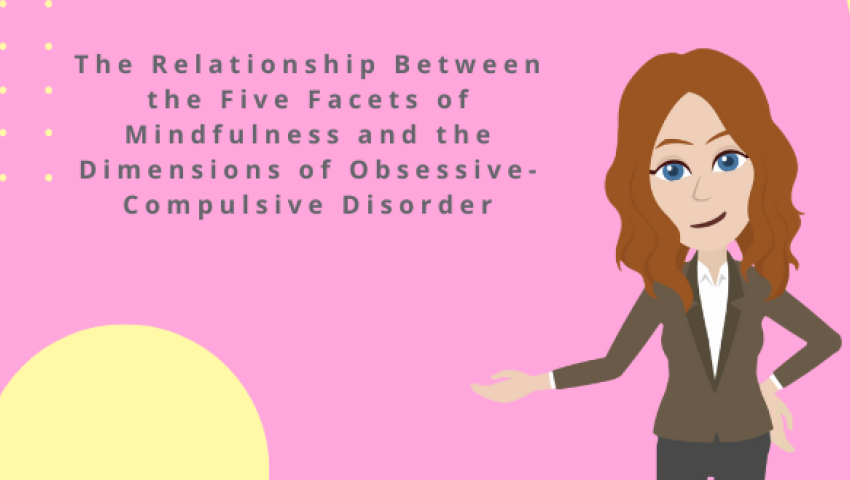
The Relationship Between the Five Facets of Mindfulness and the Dimensions of Obsessive-Compulsive Disorder
Obsessive-Compulsive Disorder (OCD) is characterized by obsessions and recurring compulsions. Obsessions are persisting, uninvited, unwanted, and anxiety-provoking thoughts, impulses, or images. In response to obsessions, compulsions ensue as an attempt to reduce distress. Compulsions are repetitive mental acts or behaviors.
Read Transcript
OCD symptoms
4 dimensions of OCD Symptoms:
- Concerns about germs and contamination,
- Concerns about being responsible for harm, injury, or bad luck,
- Unacceptable thoughts, and
- Concerns about symmetry, completeness, and the need for things to be “just right.”
It is estimated that 2.3% of adults in the U.S. will experience OCD at some point in their lifetime with females being more likely to experience it. That sounds like a small percentage. So why does this deserve attention? Because over half of people living with OCD have serious impairment in daily functioning. As an example, someone with OCD may have obsessive thoughts that there are germs on their hands. Further impairment would have them fearful of becoming sick because of potential germs on their hands. For those with serious impairment, it moves beyond obsessions to compulsions of washing their hands an excessive number of times per day to reduce their stress about becoming sick. This example portrays the importance of identifying symptoms early and providing effective treatments.
Treatment Options
Treatments such as cognitive behavior therapy (CBT) and medication can help. Yet over half of the people treated are shown to relapse. However, there is hope because mindfulness has been shown to be effective in reducing residual symptoms that CBT may not address.
Mindfulness is a heightened awareness of and attention to an incident or existing reality. In addition, with greater mindfulness comes attitudes of acceptance, openness, and curiosity. These improvements in attitude can help reduce OCD symptoms because it can serve as a coping mechanism and separate the person from their obsessions and compulsions. These positive changes in thought help with “letting go” of obsessions which, in turn, decrease symptoms. Even though mindfulness is consistently shown in studies to reduce OCD symptoms, it is not widely used and is considered a “third wave” treatment after CBT and medication. Part of the reason it is a lesser-used treatment may be because more needs to be understood about which facets of mindfulness may attribute to improved OCD symptoms.
Mindfulness
The facets of mindfulness include non-react, observe, act aware, describe, and non-judge:
- Non-react refers to one’s ability to notice but not react to feelings, emotions, and situations.
- Observe refers to one’s ability to pay attention to or notice their thoughts, feelings, perceptions, and sensations.
- Act aware refers to one’s ability to be aware, concentrate, not get distracted, and not “run on autopilot.”
- Describe refers to one’s ability to explain and label their feelings, beliefs, opinions, expectations, and thoughts.
- And lastly, non-judge refers to one’s ability to view their thoughts, perceptions, feelings, and situations without judgment.
One study found that compared to a group of people living without OCD, people living with OCD scored much lower in the mindfulness facets of describe, act aware, and non-judge, but did not differ in the mindfulness facets of observe and non-react. Not only does this allow health professionals insight as to who might be more likely to experience debilitating OCD symptoms but also it narrows down the focus of treatment to the three facets of mindfulness most impacted by OCD.
One reason I want to go into occupational therapy is to help advance work in this field so that we can support people living with OCD to live the life they want to live.
References
Abramowitz J.S., Reuman L. (2020) Obsessive Compulsive Disorder. In: Zeigler-Hill V., Shackelford T.K. (eds) Encyclopedia of Personality and Individual Differences. Springer, Cham. https://doi.org/10.1007/978-3-319-24612-3_919
American Psychiatric Association. (2013). Diagnostic and statistical manual of mental disorders (5th ed.). https://doi.org/10.1176/appi.books.9780890425596
Baer, R. A., Smith, G. T., Hopkins, J., Krietemeyer, J., & Toney, L. (2006). Using Self-Report Assessment Methods to Explore Facets of Mindfulness. Assessment (Odessa, Fla.), 13(1), 27-45. https://doi.org/10.1177/1073191105283504
Bishop, S. R., Lau, M., Shapiro, S., Carlson, L., Anderson, N. D., Carmody, J., . . . Devins, G. (2006). Mindfulness: A Proposed Operational Definition. Clinical Psychology (New York, N.Y.), 11(3), 230-241. https://doi.org/10.1093/clipsy/bph077
Bohlmeijer, E., ten Klooster, P. M., Fledderus, M., Veehof, M., & Baer, R. (2011). Psychometric Properties of the Five Facet Mindfulness Questionnaire in Depressed Adults and Development of a Short Form. Assessment (Odessa, Fla.), 18(3), 308-320. https://doi.org/10.1177/1073191111408231
Brown, K. W., & Ryan, R. M. (2003). The Benefits of Being Present. Journal of Personality and Social Psychology, 84(4), 822-848. https://doi.org/10.1037/0022-3514.84.4.822
Crowe, K., & McKay, D. (2016). Mindfulness, Obsessive-Compulsive Symptoms, and Executive Dysfunction. Cognitive Therapy and Research, 40(5), 627-644. https://doi.org/10.1007/s10608-016-9777-x
Hale, L., Strauss, C., & Taylor, B. L. (2013). The effectiveness and acceptability of mindfulness‐based therapy for obsessive compulsive disorder: A review of the literature. Mindfulness, 4(4), 375–382. https://doi.org/10.1007/s12671-012-0137-y
Hanstede, M., Gidron, Y., & Nyklíček, I. (2008). The Effects of a Mindfulness Intervention on Obsessive-Compulsive Symptoms in a Non-Clinical Student Population. The Journal of Nervous and Mental Disease, 196(10), 776-779. https://doi.org/10.1097/NMD.0b013e31818786b8
National Institutes of Mental Health (2017). Obsessive-Compulsive Disorder (OCD). https://www.nimh.nih.gov/health/statistics/obsessive-compulsive-disorder-ocd.shtml